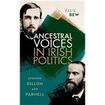
With this study of two towering figures in the Irish nationalist pantheon, Charles Stewart Parnell and John Dillon, Paul Bew immerses the reader in the dynamics of nationalist politics and Anglo-Irish relations in the late 19th and early 20th centuries and dissects the rhetoric and mentalities underpinning them with authoritativeness and panache.
Both Parnell, as chairman of the Irish Parliamentary Party (IPP), and Dillon, agrarian radical and nationalist MP for Tipperary (1880-1883) and East Mayo (1885-1918), were accomplished parliamentarians but “hardwired in different ways”. Bew uncovers much about their fraught, co-dependent relationship as they sought to find a balance in managing Irish grassroots campaigns and establishment politics.
There has been no biography of Dillon for 50 years, but Bew sees him as the “point man” for the working out of the essence of the Irish nationalist-British liberal connection with the resultant need to understand “the internal elements of his political belief system”. That system was built around hostility to landlordism (shared by many British liberals who at times found in the Irish question opportunities to undermine their Tory opponents) and initially included devotion to Young Irelander John Mitchel, right down to delivering a speech by Mitchel that included a defence of slavery, a matter on which Mitchel was trenchant.
Both Parnell and Dillon “were sent out to evangelize” in America using radical rhetoric about the Irish land question, but Parnell also managed to “develop a new art form; a rhetorical trope whereby he supported Dillon’s words while also simultaneously disavowing them”. Parnell’s decision not to endorse the path of revolutionary land agitation disappointed Dillon, who became the leading anti-Parnellite voice within the IPP and was not afraid to espouse violence, even when speaking in parliament.
Hyrox, the soaring fitness trend: ‘You meet so many different people, all shapes, all sizes’
The Last of Us review: Prepare to be shocked by this compelling new season
Finneas in Dublin review: Without his sister Billie Eilish, O’Connell shows his worth with a fun, high-quality gig
My grandfather died by suicide. I work in the same Irish university where he taught history
The Economist saw Dillon as “the nearest approach, both in temperament and in ideas to a pure Jacobin that the Irish revolutionary movement has produced”. He also endured bouts of imprisonment and withdrew from politics for three years from 1882 as Parnell sought to realign Irish nationalist politics as “a top-down movement” and focus more on London and parliament than the land war.
The book is partly about “intensity of hatred” from the late 1870s and how that propelled political strategy. As is to be expected given the author’s extensive experience going back more than 45 years – he authored Land and the National Question in Ireland 1858-1882 published in 1979 – there is illuminating material on the land war strategies and their communication to both English and Irish audiences. It is also revealing about British liberal prime minister William Gladstone’s “own complex process of rationalization and even self-deception” in relation to his handling of various Irish crises and conversion to Irish home rule. Gladstone’s intellect, it is suggested, meant “the Irish question became a question of the destiny of liberalism” and “all this had a high moral tone”.
Bew assesses Parnell’s tendency to speak out of both sides of his mouth, his sometimes paradoxical engagement with Toryism and desire to extricate himself from agrarian radical platforms. He desired “class conservative” governance of Ireland but also did much to destroy landlord hegemony.
The book contains dense analysis of a variety of political speeches and tells us much about the transformation of Dillon’s political identity and the impact of the liberal alliance on his political personality and its perception. For Dillon’s detractors he had a mind dominated by inherited prejudices, but what is also illuminated here is his evolving flexibility amid efforts to reinvent his own past, which eventually resulted in support for the British first world war effort and acceptance in 1914 of the rights of unionists.
The threat from younger radicals who considered him a spent force as support for Sinn Féin increased is a reminder that Dillon had to wrestle with the issues posed by the legacy of Parnell, who died in 1891. Dillon failed in this, but he did, argues Bew, travel a long way by diluting his agrarian radicalism, becoming a more conventional liberal and champion of the Irish nationalist-British liberal alliance. He ultimately accepted that unionists could not be forced into an all-Ireland settlement against their will, as Parnell had in May 1891 when he maintained in a speech in Belfast that “until the religious prejudices of the minority are conciliated, Ireland can never enjoy proper freedom, Ireland can never be united”.
Bew argues that their acceptance of unionist realities made Parnell and Dillon “architects for the Irish political system as it exists today”. But ultimately, as acknowledged, Dillon “could neither work with the British government and/or the unionists nor repel Sinn Féin”.
There is, to my mind, an overegging of the idea that both men were ultimately exponents of the “principle of consent” as understood in the modern peace process era. Although some parallels between the two periods can legitimately be made, the contexts are very different. And given the multitude of strategies, ambiguities, shadow language and overall turbulence, how much weight should be attached to specific speeches and interventions? Can too much be made of too little? Those judgment calls are perhaps influenced more by contemporary politics than the dynamics of the 1880-1918 period.
- Diarmaid Ferriter is professor of modern Irish history at UCD. His latest book is Between Two Hells: The Irish Civil War (Profile)













